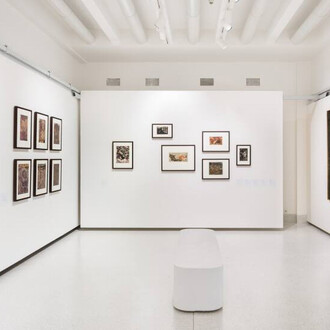Drawing is my queen. It lets me reproduce any material or object, but – unlike a painting or photograph – it does not allow any tricks or errors: What you see is what you get.
(Richard Wientzek)
The former enclosure of the Convent of St Agnes of Bohemia provides an ideal exhibition space for a cross-section of the oeuvre of German artist Richard Wientzek (b. 1970). Wientzek refers to his still lifes as “secular religious pictures” that highlight a connection with the mediaeval form of painting, whose intensive viewing led to spiritual uplift. The artist has preserved the viewer’s experience with a detailed rendering of objects that, while reproduced in the spirit of extreme verism, nevertheless retain their symbolic qualities.
Wientzek portrays objects from daily life, things like food, toys, fashion accessories, banknotes, books or stuffed birds, arranging them in still life compositions that tell a story. While some of the paintings’ titles help encode the situation, most offer an ironic comment on what we see.
Wientzek always draws his objects on a one-to-one scale, usually as seen from above and with uniformly applied light on a white background. Self-imposed restrictions meant he only used India ink and colour crayons. The dotting that evokes chiaroscuro and a three-dimensional quality is a technique borrowed from archaeological documentation that Wientzek tested and improved for a long time in the context of Antiquity science. Therefore, even the smallest of formats seeks to make a powerful impression on the viewer through the meticulousness with which each and every spot was applied.
“How I work can always be seen. When contours and shaded parts with thousands of tiny dots done in India ink are created, then each and every paper pore is saturated with several overlapping layers executed in colour crayons. I need objects, sheets of paper and colour crayons on my desk – and time for the things on the paper to grow out of them. I can say that this is a brief summation of my complex working and thinking processes.”
The artist was not formally trained, but began his career as an applied artist. In 2002, he displayed his work as a member of the “Monochrom” group at the 25th Biennale in São Paulo,Brazil. Together with his colleagues from this Vienna-based art group as well as other artists, he experimented with various forms of media art for several years; in 2005, he focused entirely on the classical genres of painting and drawing. He has participated, among others, in the following group exhibitions: “I love Alltag”, Kunsthaus Hannover (2010), “Realisme Amsterdam” (2013), “Art Fair Köln” (2014) or “Cranach 2.0 – Der internationale Lucas-Cranach-Preis 2015”,Wittenberg a Kronach (2015).
Solo exhibitions include: “Tagwerk” (Daily Work), Stadtgalerie Villa Dessauer, Bamberg (2008), “Paradies und Parkverbot” (Paradise and Parking Forbidden), Galerie Atzenhofer, Norimberk (2010), “One-Artist-Show” at Art Karlsruhe, Galerie Urlich Gering (2012), “Zeichnungen” (Drawings), Kunsthaus Hannover (2014 and 2016), “60 Songs”, Kunsthaus Hannover (2017) and “One-Artist-Show” at Art Karlsruhe, Kunsthaus Hannover (2018).
A Catalogue raisonné of the drawings of Richard Wientzek (in German and English, published by the Kunsthaus Hannover in the Kerber Verlag 2017, 256 pages) is available for purchase at the exhibition.
















